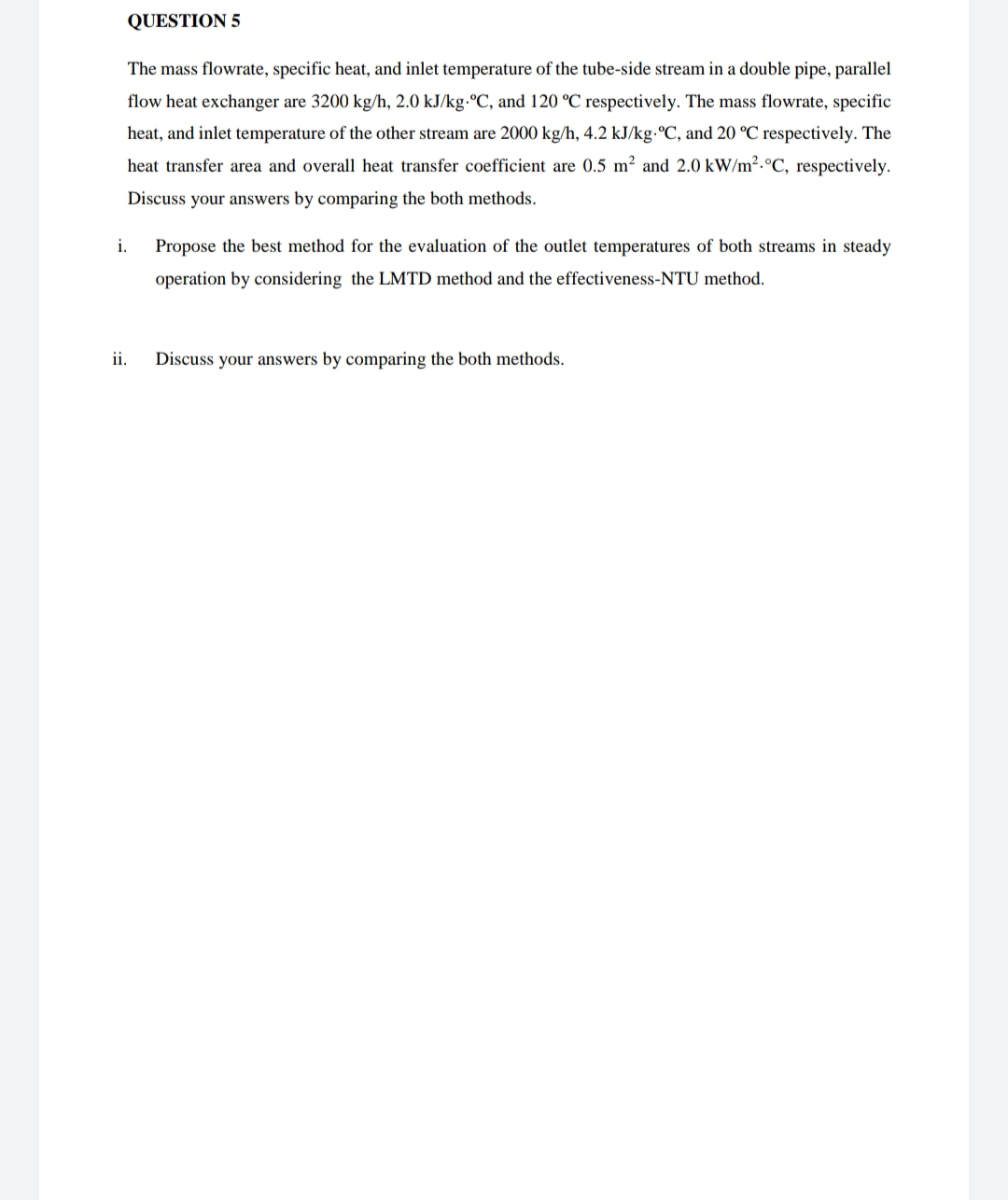QUESTION 5 The mass flowrate, specific heat, and inlet temperature of the tube-side stream in a double pipe, parallel flow heat exchanger are 3200 kg/h, 2.0 kJ/kg.ºC, and 120 °C respectively. The mass flowrate, specific heat, and inlet temperature of the other stream are 2000 kg/h, 4.2 kJ/kg.°C, and 20 °C respectively. The heat transfer area and overall heat transfer coefficient are 0.5 m? and 2.0 kW/m2.°C, respectively. Discuss your answers by comparing the both methods. Propose the best method for the evaluation of the outlet temperatures of both streams in steady operation by considering the LMTD method and the effectiveness-NTU method. ii. Discuss your answers by comparing the both methods.
QUESTION 5 The mass flowrate, specific heat, and inlet temperature of the tube-side stream in a double pipe, parallel flow heat exchanger are 3200 kg/h, 2.0 kJ/kg.ºC, and 120 °C respectively. The mass flowrate, specific heat, and inlet temperature of the other stream are 2000 kg/h, 4.2 kJ/kg.°C, and 20 °C respectively. The heat transfer area and overall heat transfer coefficient are 0.5 m? and 2.0 kW/m2.°C, respectively. Discuss your answers by comparing the both methods. Propose the best method for the evaluation of the outlet temperatures of both streams in steady operation by considering the LMTD method and the effectiveness-NTU method. ii. Discuss your answers by comparing the both methods.
Principles of Heat Transfer (Activate Learning with these NEW titles from Engineering!)
8th Edition
ISBN:9781305387102
Author:Kreith, Frank; Manglik, Raj M.
Publisher:Kreith, Frank; Manglik, Raj M.
Chapter6: Forced Convection Over Exterior Surfaces
Section: Chapter Questions
Problem 6.49P
Related questions
Concept explainers
Heat Exchangers
Heat exchangers are the types of equipment that are primarily employed to transfer the thermal energy from one fluid to another, provided that one of the fluids should be at a higher thermal energy content than the other fluid.
Heat Exchanger
The heat exchanger is a combination of two words ''Heat'' and ''Exchanger''. It is a mechanical device that is used to exchange heat energy between two fluids.
Question

Transcribed Image Text:QUESTION 5
The mass flowrate, specific heat, and inlet temperature of the tube-side stream in a double pipe, parallel
flow heat exchanger are 3200 kg/h, 2.0 kJ/kg.ºC, and 120 °C respectively. The mass flowrate, specific
heat, and inlet temperature of the other stream are 2000 kg/h, 4.2 kJ/kg.°C, and 20 °C respectively. The
heat transfer area and overall heat transfer coefficient are 0.5 m² and 2.0 kW/m2.°C, respectively.
Discuss your answers by comparing the both methods.
i.
Propose the best method for the evaluation of the outlet temperatures of both streams in steady
operation by considering the LMTD method and the effectiveness-NTU method.
ii.
Discuss your answers by comparing the both methods.
Expert Solution
This question has been solved!
Explore an expertly crafted, step-by-step solution for a thorough understanding of key concepts.
This is a popular solution!
Trending now
This is a popular solution!
Step by step
Solved in 5 steps with 5 images

Knowledge Booster
Learn more about
Need a deep-dive on the concept behind this application? Look no further. Learn more about this topic, mechanical-engineering and related others by exploring similar questions and additional content below.Recommended textbooks for you

Principles of Heat Transfer (Activate Learning wi…
Mechanical Engineering
ISBN:
9781305387102
Author:
Kreith, Frank; Manglik, Raj M.
Publisher:
Cengage Learning

Principles of Heat Transfer (Activate Learning wi…
Mechanical Engineering
ISBN:
9781305387102
Author:
Kreith, Frank; Manglik, Raj M.
Publisher:
Cengage Learning